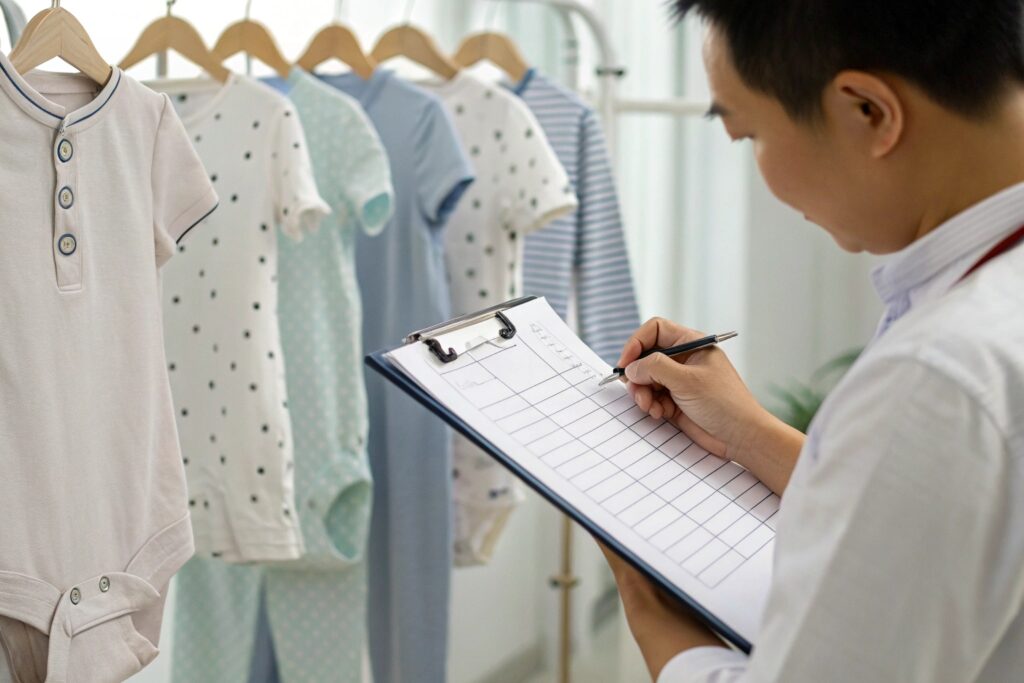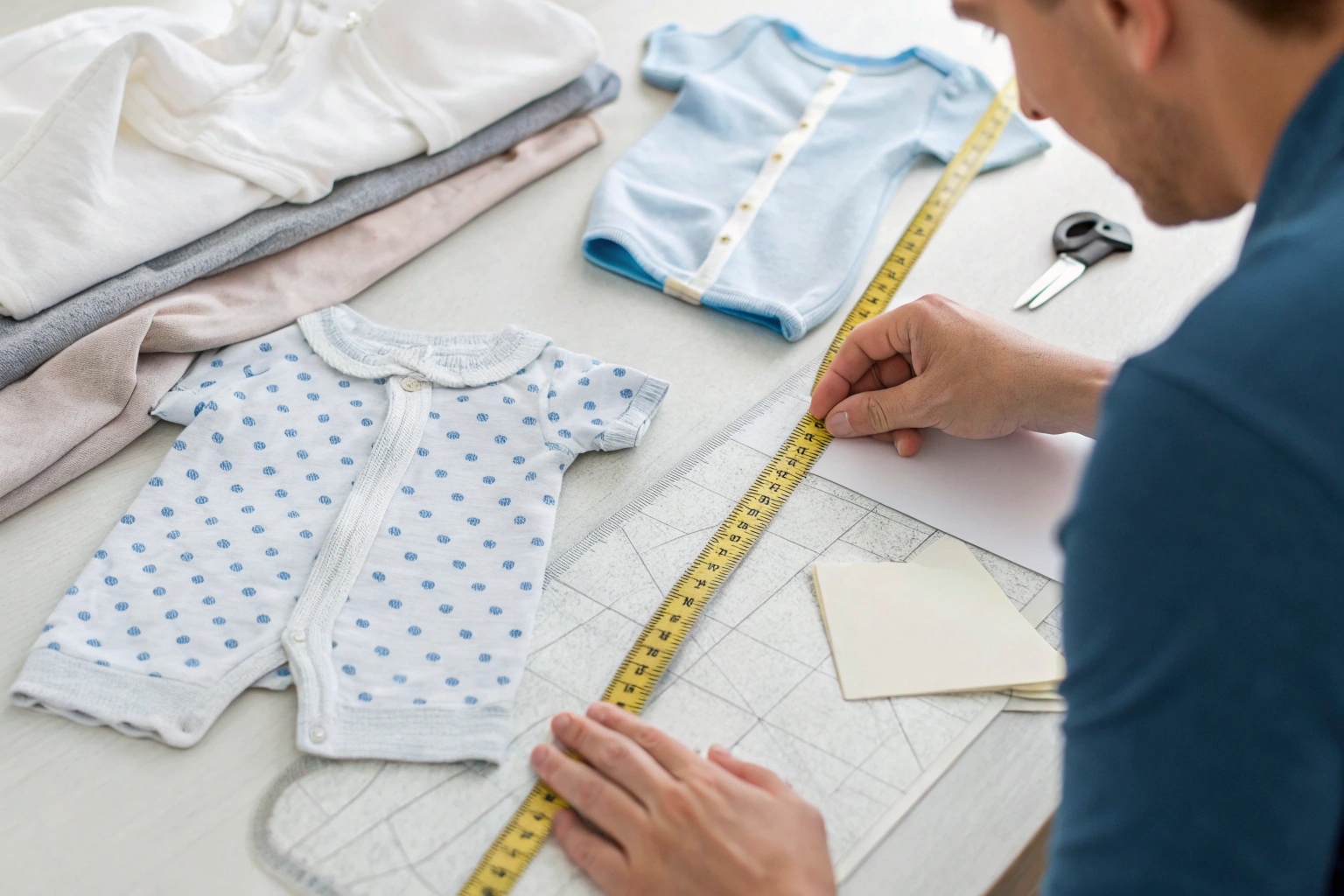Ordering kidswear from China sounds simple—until the clothes arrive too tight, too short, or two sizes off. Sizing mistakes lead to returns, bad reviews, and lost profits.
To get the right size when ordering kidswear from China, compare global size systems, provide detailed measurements, and confirm size charts before production.
Here’s how I avoid costly sizing errors—whether I’m sourcing newborn onesies or toddler jackets—from factory inquiry to final shipment.
How Chinese Kidswear Sizes Compare to US and EU?
One of the first surprises when sourcing kidswear from China is that their sizing system doesn’t match what we use in the U.S. or Europe.
Chinese kidswear sizes are based on body height in centimeters, while US and EU sizes are more age-based. This causes mismatches if not adjusted.

What are the key differences between Chinese, US, and EU sizing for newborn and toddler clothing?
Chinese sizing typically uses the child’s height as the main indicator—so a “73” size means the child is about 73 cm tall. In the U.S., sizes are labeled by age: “0–3 months,” “6–9 months,” etc. EU sizes also use height (like China) but with some overlap in age labeling.
Here’s a simplified comparison:
| China Size (cm) | US Size | EU Size |
|---|---|---|
| 59 | Newborn (0–1M) | 56 |
| 66 | 0–3 months | 62–68 |
| 73 | 6–9 months | 68–74 |
| 80 | 9–12 months | 74–80 |
| 90 | 12–18 months | 80–86 |
How do I avoid confusion between these systems when placing an order?
I always ask the supplier for their factory size chart first. Then I map it to my target market using a table like the one above. If the chart doesn’t exist, I provide my own size references and measurements. I also double-check if their “90” includes diaper room or not—some factories skip that for baby pants, which causes issues later.
What Measurements to Provide for Accurate Sizing?
Even with the right size label, poor fit can happen if measurements aren't confirmed. Sizing charts vary from factory to factory—even for the same labeled size.
To get accurate sizing, provide clear garment measurements like chest width, body length, sleeve length, and crotch depth for babywear.

What exact garment dimensions should I send to the manufacturer for newborn or toddler clothes?
For baby clothes like rompers or bodysuits, I usually send this list:
| Measurement | Description |
|---|---|
| Chest Width | From armpit to armpit |
| Body Length | From shoulder to crotch |
| Sleeve Length | From shoulder seam to cuff |
| Crotch Depth | Front waistband to crotch seam |
| Shoulder Width | Across upper shoulder seam |
| Leg Opening | Circumference of the leg hole |
I always specify whether these are body measurements or garment finished measurements—that’s important. I also include tolerance (+/- 1 cm) so factories know what’s acceptable.
Should I use inches or centimeters in the measurement chart?
I prefer using centimeters since most Chinese factories are more comfortable with metric units. If I start with inches, I always include a converted version. A small error in conversion can cause major size problems later.
Tips for Reading Chinese Kids Clothing Size Charts?
A factory might send over a size chart that looks complete—but you still end up with tight neck holes or oversized sleeves. The devil’s in the details.
To read Chinese size charts correctly, check both body and garment measurements, understand unit conversions, and clarify if allowances are included.

What are the most common mistakes buyers make when reading size charts from Chinese suppliers?
Here are a few mistakes I’ve made (and learned from):
- Confusing body size with garment size
- Assuming measurements include ease or stretch
- Forgetting that neckline and cuff openings might not be listed
- Ignoring unit mismatch (mm vs. cm)
When I get a factory chart, I mark every number with comments. If “Chest Width” is 25 cm—does that mean for a 6-month-old? Or a flat garment laid out? I ask.
How do I confirm that the factory actually follows the size chart?
After finalizing the chart, I always ask for:
- One pre-production sample made to size
- A grading sheet if multiple sizes are involved
- Photos of the measuring process
Some suppliers even send short videos measuring the sample with tape. It only takes 30 seconds, but it builds trust—and catches mistakes early.
How to Avoid Sizing Mistakes in Bulk Orders?
A small measurement error in samples can multiply into thousands of unusable garments in bulk production. That’s why size consistency matters.
To avoid sizing mistakes, approve final samples, request QC checks during production, and build sizing into your inspection checklist.

What steps should I take before mass production to lock in sizing accuracy?
Before greenlighting bulk production, I do this:
- Approve one golden sample with correct size and fit
- Confirm a grading chart if ordering multiple sizes
- Share a QC checklist that includes key size points
- Ask for random inspection reports during production
Some buyers skip the size grading sheet—and end up with inconsistent fits between 3M and 6M sizes. I’ve made that mistake too. Now, I ask for grading across every size tier.
What can go wrong during mass production—and how can I catch it early?
Factories might switch sewing teams or machines. A sample sewn by the senior tailor may not match bulk pieces. To catch that, I ask for 5 random pieces from the first 10% of production. I measure them against my chart. If they’re off, I freeze production and ask for a fix. That saves time and thousands of dollars.
Conclusion
Getting kidswear sizing right when ordering from China isn’t about luck—it’s about charts, measurements, and clear expectations. With the right process, I turn size risk into sizing confidence.










